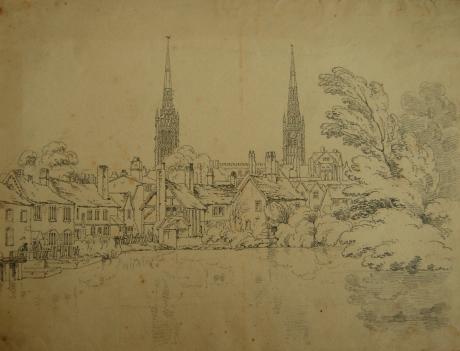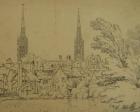on the reverse in pencil "Coventry/ Henry Edridge"
The Romans founded another settlement in Baginton and another formed around a Saxon nunnery, founded c.?AD 700 by St Osburga,[9] that was later left in ruins by King Canute's invading Danish army in 1016. Leofric, Earl of Mercia and his wife Lady Godiva built on the remains of the nunnery and founded a Benedictine monastery in 1043 dedicated to St Mary. In time, a market was established at the abbey gates and the settlement expanded.
By the 14th century, Coventry was an important centre of the cloth trade, and throughout the Middle Ages was one of the largest and most important cities in England. The bishops of Lichfield were often referred to as bishops of Coventry and Lichfield, or Lichfield and Coventry (from 1102 to 1541). Coventry claimed the status of a city by ancient prescriptive usage, was granted a charter of incorporation in 1345, and in 1451 became a county in its own right.
In the 18th and 19th centuries, Coventry became one of the three main British centres of watch and clock manufacture and ranked alongside Prescot, in Lancashire and Clerkenwell in London. As the industry declined, due mainly to competition from Swiss Made clock and watch manufacturers, the skilled pool of workers proved crucial to the setting up of bicycle manufacture and eventually the motorbike, car, machine tool and aircraft industries.
In the late 19th century, Coventry became a major centre of bicycle manufacture. The industry energised by the invention by James Starley and his nephew John Kemp Starley of the Rover safety bicycle, which was safer and more popular than the pioneering penny-farthing. The company became Rover. By the early 20th century, bicycle manufacture had evolved into motor manufacture, and Coventry became a major centre of the British motor industry. The design headquarters of Jaguar Cars is in the city at their Whitley plant and although vehicle assembly ceased at the Browns Lane plant in 2004, Jaguar's head office returned to the city in 2011, and is also sited in Whitley. Jaguar is owned by the Indian company, Tata Motors.
With many of the city's older properties becoming increasingly unfit for habitation, the first council houses were let to their tenants in 1917. With Coventry's industrial base continuing to soar after the end of the Great War a year later, numerous private and council housing developments took place across the city in the 1920s and 1930s. The development of a southern by-pass around the city, starting in the 1930s and being completed in 1940, helped deliver more urban areas to the city on previously rural land.
Coventry suffered severe bomb damage during the Second World War, most notoriously from a massive Luftwaffe air raid known as the "Coventry Blitz" on 14 November 1940. Firebombing on this date led to severe damage to large areas of the city centre and to Coventry's historic cathedral, leaving only a shell and the spire. More than 4,000 houses were damaged or destroyed, along with around three quarters of the city's industrial plants. More than 800 people were killed, with thousands injured and homeless. The Germans coined the term "Coventrate" to describe the tactics of complete urban devastation developed for the raid.
Aside from London, Hull and Plymouth, Coventry suffered more damage than any other British city during the Luftwaffe attacks, with huge firestorms devastating most of the city centre. The city was probably targeted due to its high concentration of armaments, munitions, aircraft and aero-engine plants which contributed greatly to the British war effort, although there have been claims that Hitler launched the attack as revenge for the bombing of Munich by the RAF six days before the Coventry Blitz and chose the Midlands city because its medieval heart was regarded as one of the finest in Britain. Following the raids, the majority of Coventry's historic buildings could not be saved as they were in ruinous states or were deemed unsafe for any future use. Several structures were demolished simply to make way for modern developments which saw the city centre's buildings and road infrastructure altered almost beyond recognition by 1970.
Further housing developments in the private and public sector took place after the Second World War, partly to accommodate the growing population of the city and also to replace condemned and bomb damaged properties, including a major prefabricated housing district in south Canley which exists to this day.
In the post-war years Coventry was largely rebuilt under the general direction of the Gibson Plan, gaining a new pedestrianised shopping precinct (the first of its kind in Europe on such a scale) and in 1962 Sir Basil Spence's much-celebrated new St Michael's Cathedral (incorporating one of the world's largest tapestries) was consecrated. Its prefabricated steel spire (flèche) was lowered into place by helicopter.
Major expansion to Coventry had taken place previously, in the 1920s and 1930s, to provide housing for the large influx of workers who came to work in the city's booming factories. The areas which were expanded or created in this development included Radford, Coundon, Canley, Cheylesmore and Stoke Heath.
Edridge, Henry (1768–1821), portrait painter and landscape draughtsman, was born at Paddington, Middlesex, in August 1768, and baptized in St James's, Paddington, on 3 October 1768, the son of Henry Edridge, a tradesman in St James's and his wife, Sarah, née Brett. He was educated by his mother and at a school in Acton, before being apprenticed at fifteen to the mezzotint engraver William Pether. Edridge acquired an eye for detail in this meticulous work; he was also given permission to study his master's other work as a miniaturist. He attended the Royal Academy Schools from 1784 and his copies after the works of Reynolds were much admired by Sir Joshua. He married Ann in 1789 and at the same time set up in London on his own at 14 Church Street, Soho, and then at 5 Old Compton Street. He was in business at 10 Dufour's Place from 1790 to 1799, when his reputation was being established, and also worked from a cottage he had purchased at Hanwell, Middlesex. In 1789 Edridge had become acquainted with the landscape watercolourist Thomas Hearne, and went sketching with him, adopting a little of his style and technique. Through Hearne he met Dr Thomas Monro and after 1794 attended Monro's unofficial drawing school at Adelphi Terrace in company with J. M. W. Turner and Thomas Girtin. But Edridge was already becoming well known for a style of portraiture that combined the delicacy of miniature painting with breadth of draughtsmanship and also included landscape. His earliest (anonymous) biographer stated:
It was only of late years that he made those elaborately high-finished pictures on paper, uniting the depth and richness of oil paintings with the freedom and freshness of water-colours, and of which there is perhaps scarcely a nobleman's family in England without some specimens. (Georgian Era)
It was not strictly true that these watercolour full-lengths were late works: he had been engaged on them since 1790 but perfected them from 1805 to 1810, when he exhibited almost 200 at the Royal Academy. Edridge drew his subject in soft lead pencil, applying watercolour with a miniaturist's technique of stippling, principally to the face and hands, but using some washes or body colour to enrich the drapery. His meticulous pencil lines, occasionally strengthened by pen, give his figures a posed appearance, but the accuracy of dress and detail is remarkable. An accomplished landscape draughtsman, Edridge used trees, especially silver birches, to enliven the background, and details of a house or a terrace to set the figure in a topographical context. The outline and the drapery of his sitters exactly suited the neo-classical mood of the time.
Joseph Farington gave some indication of Edridge's popularity when he noted in his diary on 30 December 1805 that he was invited to Windsor in 1805, ‘where he is employed in making a set of drawings of the Princesses to be presented by them to the Queen—He is now established at the Equerry's table’ (Farington, Diary, 7.2667). Edridge aimed to paint individual portraits of families as he moved from house to house in his fashionable circle. But his rarer group portraits, for example, Unknown Gentleman with Children (V&A) or The Vere Poulett Family (Cecil Higgins Art Gallery, Bedford), are equally finished productions, often showing the family's interests as painters, musicians, antiquaries, or sportsmen. They seldom include more than three figures. In August 1802 he was at Merton, Surrey, with Sir William and Lady Hamilton, drawing Lord Nelson's portrait; in February 1805 he made a portrait of William Pitt, and in June 1809 William Wilberforce sat to him. He was patronized by such leaders of taste as Sir George Beaumont and Sir John Leicester. On 30 March 1806 Farington recorded that Edridge was able to raise his charge for a full-length portrait drawing from 15 to 20 guineas (ibid., 2706). Neither did he neglect his landscape work, often in pen outline with very sensitive rendering of architecture and great virtuosity in detailing carving and stone. He made several trips abroad at the end of his life, notably to Normandy in 1818 or 1819, and to Paris in 1820, when he specialized in views of the great Gothic churches.
Edridge was quiet and well mannered, and of gentlemanly appearance. A portrait drawing of Edridge by Thomas Monro, formerly in the Panzer collection (reproduced in Houfe) shows a heavy-jowled man of middle age with an aquiline nose, side whiskers, and a good head of hair. Edridge was very anxious to be elected to the Royal Academy, but Farington noted on 18 June 1808 that, as he was a watercolourist, Thomas Lawrence did not consider Edridge in a line to be admitted (Farington, Diary, 9.3299). He was eventually elected an associate of the Royal Academy in 1820, possibly on the strength of his Normandy landscapes.
Edridge died of heart disease at his home, 65 Margaret Street, London, on 23 April 1821 and was buried on 30 April at Bushey parish church, Hertfordshire. He left a fortune of £12,000 to his widow and executors. Examples of Edridge's work may be found in the National Portrait Gallery, the British Museum (including three sketch-books), and the Victoria and Albert Museum, London; the Ashmolean Museum, Oxford; the Fitzwilliam Museum, Cambridge; Birmingham City Art Gallery; the Laing Art Gallery, Newcastle; and Saltram, Devon.
Simon Houfe DNB



